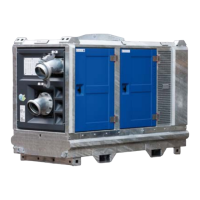BA series pumps
1401 Pump unit with diesel drive
8.33
Radiator - Clean
The radiator is not usually supplied by Perkins. The following text describes a typical cleaning
procedure for the radiator. Refer to the OEM information for further information on cleaning the radiator.
NOTICE
Adjust the frequency of cleaning according to the effects of the operating environment.
Inspect the radiator for these items: damaged fins, corrosion, dirt, grease, insects, leaves, oil, and other
debris. Clean the radiator, if necessary.
WARNING
Personal injury can result from air pressure. Personal injury can result without
following proper procedure. When using pressure air, wear a protective face shield
and protective clothing.
Maximum air pressure at the nozzle must be less than 205 kPa (30 psi) for cleaning
purposes.
Pressurized air is the preferred method for removing loose debris. Direct the air in the opposite
direction to the fan's air flow. Hold the nozzle approximately 6 mm (0.25 inch) away from the radiator
fins.
Slowly move the air nozzle in a direction that is parallel with the radiator tube assembly. This will
remove debris that is between the tubes.
Pressurized water may also be used for cleaning. The maximum water pressure for cleaning purposes
must be less than 275 kPa (40 psi). Use pressurized water in order to soften mud. Clean the core from
both sides.
Use a degreaser and steam for removal of oil and grease. Clean both sides of the core. Wash the core
with detergent and hot water. Thoroughly rinse the core with clean water.
If the radiator is blocked internally, refer to the OEM Manual for information regarding flushing the
cooling system.
After cleaning the radiator, start the engine. Allow the engine to operate at low idle speed for three to
five minutes. Accelerate the engine to high idle. This will help in the removal of debris and drying of the
core. Slowly reduce the engine speed to low idle and then stop the engine. Use a light bulb behind the
core in order to inspect the core for cleanliness. Repeat the cleaning, if necessary.
Inspect the fins for damage. Bent fins may be opened with a “comb”. Inspect these items for good
condition: Welds, mounting brackets, air lines, connections, clamps, and seals.
Make repairs, if necessary.

